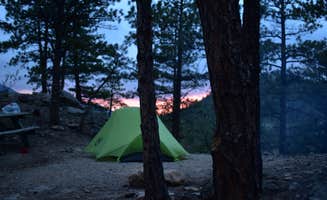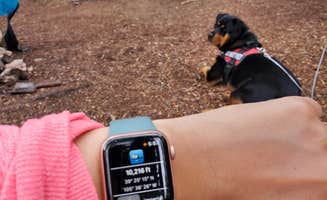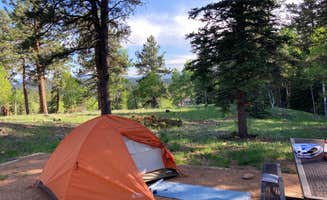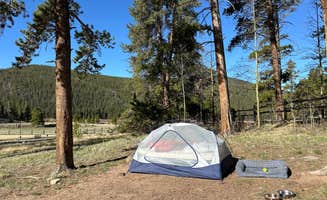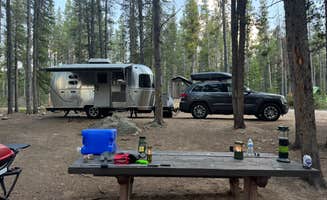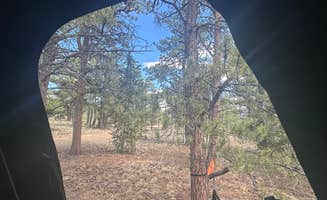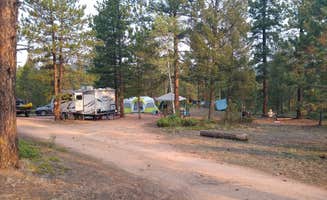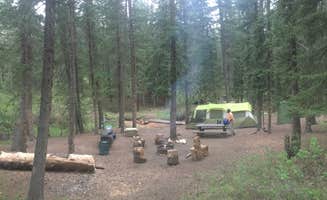Camping spots near Shawnee, Colorado vary widely in elevation from 7,800 feet to nearly 10,000 feet at Geneva Park Campground. The region experiences extreme temperature fluctuations, with summer days reaching the 80s but dropping into the 40s overnight. Many access roads leading to primitive sites become severely rutted after heavy rainfall, making high-clearance vehicles necessary for backcountry campers during Colorado's monsoon season.
What to do
Horseback riding trails: Check trail conditions Access points near Bruno Gulch Dispersed connect to equestrian-friendly paths. "There are great spots hidden in the trees. Dispersed free spots," notes Nick P., while another reviewer highlights "Equestrian friendly!! Except when irresponsible campers go up into the horse trails and shoot their guns for 8 hours on Saturday when we were there."
Mountain biking network: All skill levels welcome The extensive trail system at Buffalo Creek Recreation Area offers routes for beginners and advanced riders. A mountain biker called it "A mountain biker's dream" and explained that while it's "Not whistler in terms of terrain but plenty of trails for various ability levels." Another camper mentioned you can "easily hit a reasonable bed time" with the noise restrictions in place.
High alpine hiking: Pack for rapid weather changes Several trailheads originate from campgrounds along Guanella Pass. "Camp here to hike one of Colorado's most climbed 14ers, Mt. BIERSTADT. This pass can get CROWDED so plan to leave Denver early on a Friday," states one hiker. Morning starts are essential during summer when afternoon thunderstorms typically develop.
What campers like
Creek-side spots: Water sound therapy Many campers seek sites near running water at Deer Creek Campground. "You can hear the water and the creek is right next to your site. Bathrooms were very well maintained," reports Claire. Another camper observed that "Depending where you camp you can hear the water from the stream."
Distance between sites: Privacy varies by location At Wellington Lake, sites offer different privacy levels. "There are great sites right on the water with plenty of tree shade and privacy," reports Eric L. For those wanting maximum seclusion: "For more privacy go further away from the water," advises Victoria H. Woodland sites typically offer more separation than waterfront locations.
Shade coverage: Protection from summer sun Pine forests dominate many camping areas. At Kenosha Pass Campground, campers appreciate that "Campground is beautiful and it is right on the Colorado Trail. Several spots are large enough for a big camper." Another reviewer notes it's "densely wooded sites with shade" making summer camping more comfortable.
What you should know
Fire restrictions: Seasonal changes affect campfires Fire bans frequently impact the region during dry periods. Campers should always check current restrictions before arrival. "Currently they don't have day-use open, so there's plenty of space at the lake to set-up and spend the day playing with the kids," noted one Wellington Lake visitor during restricted periods.
Cell service: Limited connectivity Most dispersed camping areas and many established campgrounds have minimal or no cell reception. One Kirby Gulch visitor explained: "The road gets very bumpy so low clearance vehicles are not advised. Saw a Subaru Outback make it okay but nothing less than that."
Extreme popularity: Early arrival recommended Sites fill quickly, especially during summer weekends. "This place is now getting so popular that people are leaving their rigs and tents in their sites during the week and coming back for the weekend which is not cool," reports Chris P. from Bruno Gulch. Another camper noted, "Hard to find spots on a weekend. Beautiful spot with easy access to lots of trails and Wellington lake."
Tips for camping with families
Kid-friendly water areas: Supervised play Several campgrounds feature safe creek access. At Castle Mountain Recreation Area, "Currently they don't have day-use open, so there's plenty of space at the lake to set-up and spend the day playing with the kids," notes Heather L. Another camper warns about waterfall safety: "The rocks are so slick—don't let kids/dogs try to climb through or over."
Wildlife viewing: Early mornings best Dawn offers prime wildlife spotting opportunities. "We stayed in a mountain site (not lake-front) and the kids loved climbing the rocks and exploring the mountain," says one parent. Another visitor to the region reported, "Seen a moose and goats close to our campsite."
Weather preparation: Pack for temperature swings Even summer nights drop into the 40s at higher elevations. One camper at Kirby Gulch advised: "It did get pretty cool at night, and our kids definitely let us know about it. Luckily we have extra blankets to insulate their bags and another person in our party had a small heater. But even in July, plan for cooler night time temps and rain!"
Tips from RVers
Site leveling: Scout before setting up Many campgrounds have uneven parking pads. At Geneva Park Campground, one RVer noted: "Some may be very difficult to use if you have a trailer or even a roof tent due to the driveways being washed out or very uneven." Another camper confirms: "The dirt loop road through the site is rather eroded in spots with large divots that require very slow going with a trailer."
Access road assessment: Research before arrival High-clearance vehicles are recommended for many areas. "The dirt roads to get in there is pretty gnarly. Definitely need four-wheel-drive. Lots of rocks and deep holes and even some flooded areas," warns one camper about Kirby Gulch. Roads to Wellington Lake and Buffalo Creek recreation areas can also become challenging after rainfall.
Site selection: Check measurements Many campgrounds have size restrictions. "Not too bad of a campground. We weren't sure if we could find a walk up campsite available so we headed up on a Wednesday in June. There are 36 sites of which 10 are FCFS (sites 29-38). We found a great spot to fit our 29' camper plus truck well," reports Heather R. from Buffalo Campground.


